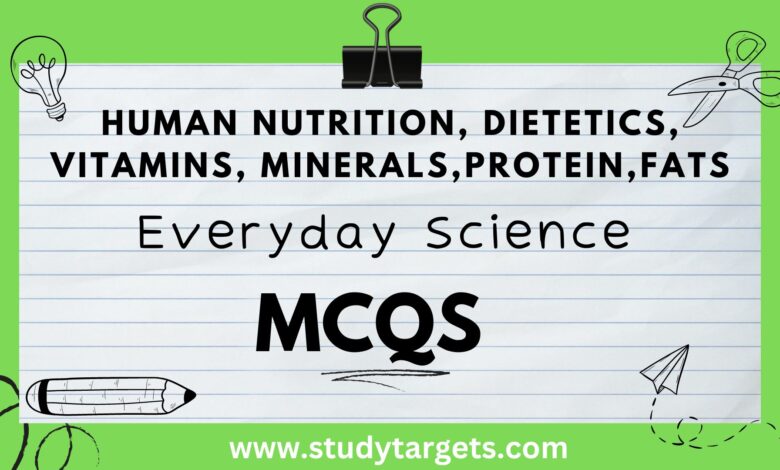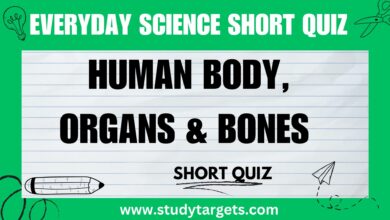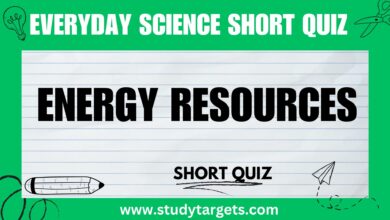MCQs: Human Nutrition & Dietetics,Vitamins, Minerals,Protein,Fats:Everyday Science MCQs

Human Nutrition & Dietetics
1. Which of the following nutrients is the primary source of energy for the body?
a) Proteins
b) Carbohydrates
c) Fats
d) Vitamins
Answer: b) Carbohydrates
2. What is the function of vitamin C in the body?
a) Promotes healthy vision
b) Enhances bone strength
c) Supports the immune system
d) Aids in blood clotting
Answer: c) Supports the immune system
3. The main function of dietary fiber in the diet is to:
a) Provide energy
b) Regulate blood sugar levels
c) Promote muscle growth
d) Aid in digestion and prevent constipation
Answer: d) Aid in digestion and prevent constipation
4. Which mineral is essential for maintaining healthy bones and teeth?
a) Iron
b) Calcium
c) Potassium
d) Zinc
Answer: b) Calcium
5. What is the primary function of B-vitamins in the body?
a) Support brain health
b) Regulate blood pressure
c) Enhance muscle strength
d) Facilitate energy metabolism
Answer: d) Facilitate energy metabolism
6. A person who avoids all animal products, including meat, dairy, and eggs, is following which type of diet?
a) Vegan
b) Paleo
c) Mediterranean
d) Atkins
Answer: a) Vegan
7. Which of the following is a complete protein source, containing all essential amino acids?
a) Rice
b) Lentils
c) Quinoa
d) Corn
Answer: c) Quinoa
8. The hormone insulin is responsible for regulating the metabolism of which nutrient?
a) Fats
b) Carbohydrates
c) Proteins
d) Vitamins
Answer: b) Carbohydrates
9. Which of the following foods is a good source of omega-3 fatty acids?
a) Olive oil
b) Avocado
c) Salmon
d) Coconut oil
Answer: c) Salmon
10. Excess intake of which nutrient is most likely to lead to weight gain?
a) Protein
b) Fiber
c) Vitamins
d) Fats
Answer: d) Fats
11. What is the role of iron in the body?
a) Regulates blood pressure
b) Aids in protein synthesis
c) Enhances immunity
d) Carries oxygen in the blood
Answer: d) Carries oxygen in the blood
12. Which vitamin deficiency can lead to the disease known as “scurvy”?
a) Vitamin A
b) Vitamin C
c) Vitamin D
d) Vitamin E
Answer: b) Vitamin C
13. What is the recommended daily intake of water for an average adult?
a) 2 liters
b) 4 liters
c) 8 liters
d) It varies based on individual factors
Answer: d) It varies based on individual factors
14. Which of the following foods is a good source of potassium?
a) Bananas
b) Oranges
c) Apples
d) Grapes
Answer: a) Bananas
15. The body’s metabolism can be influenced by:
a) Genetics
b) Exercise
c) Hormones
d) All of the above
Answer: d) All of the above
16. What is the recommended daily intake of sodium for most adults?
a) 500 mg
b) 1500 mg
c) 3000 mg
d) 5000 mg
Answer: b) 1500 mg
17. Which nutrient is essential for maintaining healthy eyesight?
a) Vitamin C
b) Vitamin D
c) Vitamin A
d) Vitamin K
Answer: c) Vitamin A
18. What is the body’s main source of energy during prolonged periods of physical activity?
a) Carbohydrates
b) Fats
c) Proteins
d) Minerals
Answer: b) Fats
19. Which of the following is NOT a fat-soluble vitamin?
a) Vitamin A
b) Vitamin D
c) Vitamin C
d) Vitamin E
Answer: c) Vitamin C
20. A person diagnosed with celiac disease should avoid which nutrient?
a) Protein
b) Fiber
c) Carbohydrates
d) Gluten
Answer: d) Gluten
21. Which of the following minerals is essential for normal nerve function and muscle contractions?
a) Calcium
b) Magnesium
c) Iron
d) Zinc
Answer: b) Magnesium
22. Which of the following foods is a good source of vitamin K?
a) Citrus fruits
b) Spinach
c) Eggs
d) Milk
Answer: b) Spinach
23. Which macronutrient is the most calorie-dense, providing approximately 9 calories per gram?
a) Proteins
b) Carbohydrates
c) Fats
d) Fiber
Answer: c) Fats
24. The condition known as “osteoporosis” is characterized by:
a) Low blood sugar levels
b) Weak and brittle bones
c) Excessive hair growth
d) Elevated blood pressure
Answer: b) Weak and brittle bones
25. Which of the following vitamins is synthesized by the body when exposed to sunlight?
a) Vitamin A
b) Vitamin C
c) Vitamin D
d) Vitamin B12
Answer: c) Vitamin D
26. What is the function of antioxidants in the body?
a) Facilitate digestion
b) Strengthen bones
c) Neutralize harmful free radicals
d) Promote muscle growth
Answer: c) Neutralize harmful free radicals
27. Which nutrient is essential for the production and maintenance of healthy red blood cells?
a) Iron
b) Zinc
c) Vitamin C
d) Potassium
Answer: a) Iron
28. A diet high in saturated fats is associated with an increased risk of:
a) Type 2 diabetes
b) Osteoporosis
c) Heart disease
d) Vitamin deficiency
Answer: c) Heart disease
29. What is the main role of phosphorus in the body?
a) Regulating blood sugar levels
b) Supporting nerve function
c) Building strong bones and teeth
d) Enhancing vision
Answer: c) Building strong bones and teeth
30. Which of the following nutrients is crucial for the synthesis of hemoglobin in red blood cells?
a) Vitamin B12
b) Folate (Vitamin B9)
c) Vitamin C
d) Vitamin K
Answer: b) Folate (Vitamin B9)
Vitamins:
1. Vitamin A is essential for:
a) Healthy vision
b) Strong bones
c) Blood clotting
d) Muscle growth
Answer: a) Healthy vision
2. Which vitamin is necessary for the absorption of calcium and phosphorus in the body?
a) Vitamin C
b) Vitamin D
c) Vitamin B12
d) Vitamin K
Answer: b) Vitamin D
3. A deficiency of vitamin B1 (thiamine) can lead to which disease?
a) Scurvy
b) Beriberi
c) Rickets
d) Night blindness
Answer: b) Beriberi
4. Which vitamin is an antioxidant and protects cells from damage caused by free radicals?
a) Vitamin A
b) Vitamin C
c) Vitamin E
d) Vitamin K
Answer: c) Vitamin E
5. Vitamin K is important for:
a) Healthy skin
b) Blood clotting
c) Immune function
d) Energy production
Answer: b) Blood clotting
Carbohydrates:
6. Which carbohydrate is the primary source of energy for the brain and muscles?
a) Starch
b) Glucose
c) Sucrose
d) Fructose
Answer: b) Glucose
7. Simple carbohydrates are composed of:
a) One type of sugar molecule
b) Long chains of glucose molecules
c) Both glucose and fructose
d) Fatty acids and glycerol
Answer: a) One type of sugar molecule
8. Which carbohydrate is commonly known as table sugar?
a) Starch
b) Glucose
c) Sucrose
d) Lactose
Answer: c) Sucrose
9. Which complex carbohydrate is found in plant cell walls and aids in digestion?
a) Starch
b) Glycogen
c) Fiber
d) Sucrose
Answer: c) Fiber
Protein:
10. Proteins are composed of:
a) Amino acids
b) Glucose molecules
c) Fatty acids
d) Nucleic acids
Answer: a) Amino acids
11. Which of the following is an example of a complete protein source?
a) Rice
b) Lentils
c) Quinoa
d) Chicken
Answer: d) Chicken
12. The process of denaturation can alter the structure of proteins due to:
a) Heat or acid
b) Freezing
c) Mixing with fiber
d) Exposure to light
Answer: a) Heat or acid
13. Which protein is found in milk and dairy products?
a) Casein
b) Gluten
c) Collagen
d) Hemoglobin
Answer: a) Casein
Fats and Oil:
14. Fats are composed of:
a) Amino acids
b) Glucose molecules
c) Fatty acids and glycerol
d) Nucleic acids
Answer: c) Fatty acids and glycerol
15. Which type of fat is considered unhealthy and is associated with an increased risk of heart disease?
a) Saturated fat
b) Unsaturated fat
c) Trans fat
d) Monounsaturated fat
Answer: c) Trans fat
16. Omega-3 and omega-6 are examples of:
a) Saturated fats
b) Monounsaturated fats
c) Polyunsaturated fats
d) Trans fats
Answer: c) Polyunsaturated fats
17. Which type of fat is solid at room temperature?
a) Saturated fat
b) Unsaturated fat
c) Monounsaturated fat
d) Polyunsaturated fat
Answer: a) Saturated fat
Minerals:
18. Which mineral is essential for nerve function, muscle contraction, and maintaining a regular heartbeat?
a) Calcium
b) Iron
c) Magnesium
d) Sodium
Answer: c) Magnesium
19. Zinc is important for:
a) Red blood cell production
b) Strong bones and teeth
c) Wound healing and immune function
d) Energy production
Answer: c) Wound healing and immune function
20. Iodine is a component of which hormone produced by the thyroid gland?
a) Insulin
b) Thyroxine
c) Estrogen
d) Testosterone
Answer: b) Thyroxine
21. Iron is a crucial component of which protein in red blood cells that carries oxygen?
a) Hemoglobin
b) Insulin
c) Collagen
d) Myoglobin
Answer: a) Hemoglobin
22. Which mineral is essential for maintaining healthy bones and teeth?
a) Calcium
b) Phosphorus
c) Potassium
d) Zinc
Answer: a) Calcium
23. Which mineral is required for the proper functioning of enzymes involved in energy metabolism?
a) Iron
b) Calcium
c) Magnesium
d) Phosphorus
Answer: c) Magnesium
Fiber:
24. Dietary fiber can be classified into two types: soluble and insoluble. Which type of fiber aids in lowering cholesterol levels?
a) Soluble fiber
b) Insoluble fiber
Answer: a) Soluble fiber
25. What is the primary function of fiber in the diet?
a) Providing energy
b) Enhancing muscle strength
c) Aiding in digestion and preventing constipation
d) Promoting healthy skin
Answer: c) Aiding in digestion and preventing constipation
26. Legumes, whole grains, fruits, and vegetables are good sources of:
a) Protein
b) Fats
c) Fiber
d) Vitamins
Answer: c) Fiber
27. Which type of fiber promotes a feeling of fullness and can help with weight management?
a) Soluble fiber
b) Insoluble fiber
Answer: b) Insoluble fiber
28. Fiber is important for maintaining a healthy:
a) Liver
b) Heart
c) Pancreas
d) Lungs
Answer: b) Heart
29. Which type of fiber can bind to toxins in the digestive tract and help eliminate them from the body?
a) Soluble fiber
b) Insoluble fiber
Answer: a) Soluble fiber
30. Which of the following foods is a good source of fiber?
a) White rice
b) Whole wheat bread
c) Candy
d) Butter
Answer: b) Whole wheat bread




